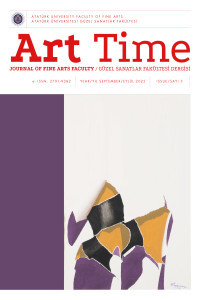Erzurum’da Yaşayan Geleneksel Mesleklerden Yüncülük
Gelenek, tabiatı gereği kendini geleceğe taşıma kapasitesine sahiptir. Bu kapasitenin ne oranda gerçekleşip
gerçekleşemeyeceği, içerisinde bulunulan medeniyet ve kültür seviyesi ile doğrudan bağlantılıdır. Özellikle ilgili toplumun üretim formunda yaşanan değişiklikler mevcudun korunması, yaşatılması sürecinde
olabildiğince önem taşımaktadır ki bu süreçte geleneksel olanın geleceğe intikalinde en büyük engel yaşam
form ve araçlarında ortaya çıkan popülarite tercihidir. Bu tercihten menfi açıdan doğrudan etkilenen kültür
temelli mevcut içerisinde en dikkate değer olanı geleneksel mesleklerdir. Geleneksel meslekler içerisinde
mevcuda gerek ticari gerekse turistik değişiklikler içermek suretiyle adapte olabilenler hayatta kalmayı
başarırken, mevcuda bir şekilde adapte olamayanların can çekiştiği veya sonlandığı görülmektedir ki bu
mesleklerden biri de çalışmamıza da konu olan yüncülüktür. Yakın dönemlere kadar özellikle evlilik geçiş
döneminin olmazsa olmazları arasında yer alan yün, sadece kız evinin oğlan evi tarafından talep ettiği düğün
öncesi bir nesne olmanın ötesinde, beden sağlığına dönük artıları nedeniyle de ilgi görmüştür. Bu ilgi, gerek
kentleşme gerekse yünün temini, temizliği ve muhafazasında göze alınması gereken iş gücü ve arz talep ilişkisi
etrafında günden güne azalarak çalışmamıza konu olan mesleğin süratle kan kaybetmesine neden olmuştur. Bu
doğrultuda çalışmamızda, sayıları bir elin parmaklarını geçmeyecek temsilci ile yaşam mücadelesi veren
yüncülük mesleği, Erzurum ili özelinde, saha çalışması metadolojisi eşliğinde elde edilen veriler etrafında
irdelenecek, mesleğin dünü, bugünü ve yarını meslek erbabı nazarından dikkatlere sunulacaktır.
Anahtar Kelimeler:
Geleneksel Meslekler, Erzurum, Meslek, Yün, Yüncülük
Wool Industry: One of Traditional Occupations in Erzurum
Tradition, by its very nature, has the capacity to carry itself into the future. The extent to which this
capacity can be realized or not is directly related to the level of civilization and culture. In particular, changes
in the production form of the relevant society are as important as possible in the process of preserving and
sustaining the existing, and in this process, the biggest obstacle in the transfer of the traditional to the future is
the popularity preference that emerges in life forms and tools. The most notable among the existing culturebased professions that are negatively affected by this preference are traditional occupations. Among the
traditional professions, those who can adapt to the existing business by including both commercial and touristic
changes are able to survive, while those who cannot adapt to the current one somehow die or die, one of these
professions is woolen, which is also the subject of our study. Wool, which has been among the sine qua non of
the marriage transition period until recently, has attracted attention not only because of being a pre-wedding
object demanded by the girl's house by the boy's house, but also because of its benefits for physical health.
This interest has decreased day by day around the labor force and supply-demand relationship, which should
be taken into account both in urbanization and in the supply, cleaning and preservation of wool, causing the
profession, which is the subject of our study, to lose ground rapidly. In this direction, in our study, the woolen
profession, which struggles for life with representatives whose number will not exceed the fingers of one hand,
will be examined around the data obtained in the field of fieldwork methodology in Erzurum province, and the
past, present and future of the profession will be brought to the attention from the point of view of the
professionals.
Keywords:
Traditional Professions, Erzurum, Profession, Wool, Woolen,
___
- Arslan, F., Çağlar, and Gürbıyık, C. (2017). Kültürel miras kapsamında kaybolmaya yüz tutmuş geleneksel meslekler: Turgutlu Örneği. Studies of The Ottoman Domain (Osmanlı Hakimiyet Sahası Çalışmaları), 7(13).
- Bahtiyari, M. İ., Akca, C. and Duran, K. (2008). Yün lifinin yeni kullanım olanakları. Tekstil ve Konfeksiyon, 18(1).
- Ekici, M. (2004). Bir sempozyumun ardından: somut olmayan kültürel mirasın müzelenmesi. Millî Folklor, 16(61).
- Karadeniz, S. (2007). Gelenek üzerine bir okuma denemesi “Geçmişle gelecek arasında gelenek. Milel ve Nihal, 4(2).
- Karakaş, A. (2017). Bir sivil toplum örgütü: Ahilik. Uluslararası Batı Karadeniz Sosyal ve Beşeri Bilimler Dergisi, 1 (1), 1-20.
- Kolaç, E. (2009). Somut olmayan kültürel mirası koruma, bilinç ve duyarlılık oluşturmada Türkçe eğitiminin önemi. Milli Folklor, 21(82).
- Uslu, B. (2021). Kadim tıptan modern tıbba yünün medikal kullanımı. Bütünleyici ve Anadolu Tıbbı Dergisi, 2 (2), 18-29.
- Özcan, Ü. B. and Bozkaya, A. (2021). Türk yorgan sanatı ve Şanlıurfa’da geleneksel yorgancılık. Tarih ve Gelecek Dergisi, 7(4), 927-958.
- Yurtseven, H.and Kaya, O. (2010). Topluluk girişimciliği ve geleneksel meslekler. Girişimcilik ve Kalkınma Dergisi, 19.
- Başlangıç: 2021
- Yayıncı: Atatürk Üniversitesi
